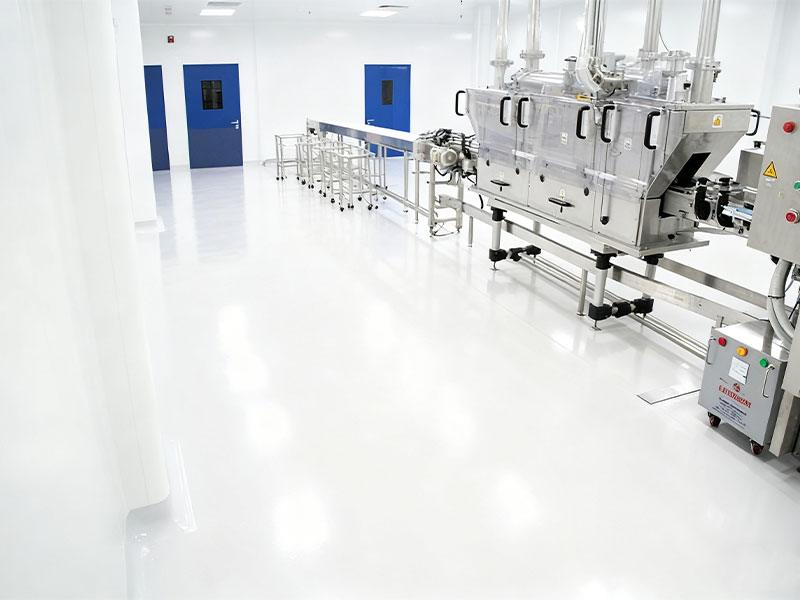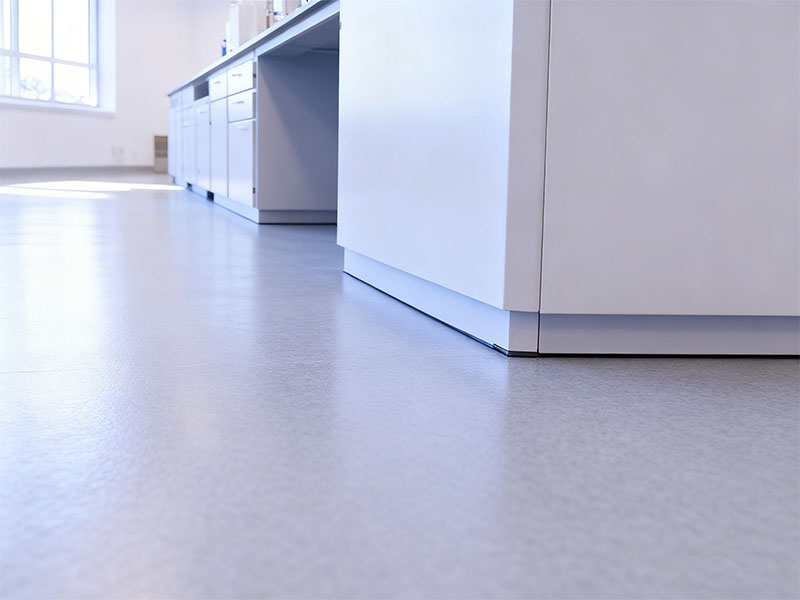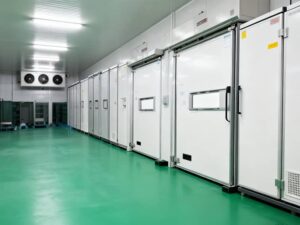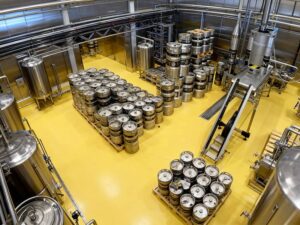Selecting the right flooring is a critical compliance and operational decision for any pharmaceutical facility. The optimal choice for most modern applications is Polyurethane (PU) flooring, due to its superior chemical resistance, durability, and cleanability. This guide provides a step-by-step framework for choosing a PU flooring system by evaluating regulatory requirements, operational demands, mechanical stresses, and installation expertise, ensuring a solution that supports both product quality and facility longevity.
Understand the Non-Negotiable: Regulatory Compliance and Classification
Why it matters: Pharmaceutical manufacturing is governed by strict global regulations like cGMP (current Good Manufacturing Practice) and standards like EU GMP Annex 1. The floor is a fundamental part of the controlled environment, directly impacting product safety.
Key Standards to Consider:
- cGMP (FDA 21 CFR Part 211): Requires floors to be non-absorbent, easily cleanable, and sanitizable to prevent contamination.
- EU GMP Annex 1: Emphasizes the need for smooth, impervious, and unbroken surfaces, making seamless and monolithic systems like PU a prime choice.
- ISO Classifications: Your facility’s ISO class (e.g., ISO 5, ISO 7, ISO 8) for cleanroom flooring dictates the required smoothness and cleanability to control particulate and microbial contamination.

Assess Your Operational and Chemical Exposure
Why it matters: Different areas within a pharmaceutical plant face unique challenges. A one-size-fits-all approach can lead to premature failure. PU flooring is renowned for its exceptional resistencia química, but the specific formulation must match the threats.
Actionable Checklist:
- List all chemicals: Document every chemical used, spilled, or cleaned with, including concentrations and temperatures (e.g., CIP fluids, solvents like acetone or isopropanol, acids, alkalis).
- Map exposure zones: Identify high-splash areas (formulation), constant spill zones (washing), and low-exposure areas (packaging).
- Compare material performance: While epoxy is common, PU flooring typically offers broader resistance, especially to a wider range of solvents and aggressive cleaning agents.
Chemical Resistance Comparison: PU vs. Epoxy Flooring
| Chemical Agent | Polyurethane (PU) Flooring | Standard Epoxy Flooring |
|---|---|---|
| Dilute Acids (10%) | Excelente | Excelente |
| Dilute Alkalis (10%) | Excelente | Excelente |
| IPA, Acetone, Methanol | Excellent to Good | Poor to Fair |
| Hot Water / Steam | Excelente | Bien |

Evaluate Physical and Thermal Stresses
Why it matters: Floors in a pharmaceutical manufacturing facility endure significant physical wear from foot traffic, wheeled carts (GMP), and falling objects. Thermal shock from hot CIP washdowns is also a major concern.
Key Performance Factors:
- Abrasion Resistance: Measured by the Taber Abrasion test (e.g., ASTM D4060). PU systems generally have higher abrasion resistance than epoxy, leading to less dust generation and longer life.
- Resistencia al impacto: The ability to withstand dropped tools or equipment without cracking. A cracked floor is a contamination risk.
- Thermal Shock Resistance: PU systems typically have a higher coefficient of thermal expansion and contraction, allowing them to better withstand rapid temperature changes from hot washdowns without delaminating or cracking. This is critical for pharmaceutical clean room flooring.
Plan for Installation, Sloping, and Long-Term Maintenance
Why it matters: The best pharmaceutical flooring system will fail if installed incorrectly. Proper planning for the pharmaceutical manufacturing floor plan, including drainage and future maintenance, is essential.
Critical Installation Considerations:
- Substrate Preparation: The concrete slab must be properly prepared, dry, and sound. This is the most critical step for long-term adhesion.
- Sloping and Drainage: The floor must be sloped correctly (typically 1-2%) to drain points to prevent water pooling, a major cGMP violation and microbial growth risk. Discuss pharmaceutical floor sloping in detail with your contractor.
- Coving: Integral coving (a seamless curve where the floor meets the wall) is a cGMP best practice, eliminating a hard-to-clean 90-degree angle.
- Tiempo de curado: Account for the facility’s downtime. PU systems can often be walked on faster than some epoxy systems.

Select a Qualified Partner and System
Why it matters: The complexity of pharmaceutical flooring solutions demands a partner with proven expertise, not just a product supplier.
Selection Criteria for a Partner:
- Proven Experience: Choose a pharmaceutical flooring contractor with verifiable project references in GMP-regulated environments.
- System Certification: Request data sheets and third-party test reports for the proposed PU system (chemical resistance, abrasion, slip resistance).
- Total Solution Offering: The best partners offer a full turnkey service: assessment, system design, professional installation, and maintenance support.
Q: What are the main types of flooring allowed in pharmaceutical manufacturing?
A: The primary types of flooring allowed in pharmaceutical manufacturing are seamless, monolithic systems. The most common are Polyurethane (PU) Cementitious/Urethane Mortars, Epoxy Mortars, and Methyl Methacrylate (MMA). PU is often preferred for its balanced performance across chemical resistance, thermal shock resistance, and durability.
Q: How does PU flooring compare to epoxy for the pharmaceutical industry?
A: While both are excellent choices, PU flooring for the pharmaceutical industry generally outperforms standard epoxy in key areas: superior resistance to a wider range of chemicals (especially solvents), better flexibility and thermal shock resistance, and higher abrasion resistance. Epoxy may be suitable for less aggressive environments.
Choosing the right pharmaceutical flooring is a multi-faceted process that directly impacts regulatory compliance, operational efficiency, and safety. By systematically evaluating your facility’s specific regulatory, chemical, physical, and installation needs, you can confidently select a high-performance Polyurethane (PU) flooring system. This investment ensures a durable, cleanable, and compliant foundation that protects your products and your facility for years to come.
KAIDA PAINT Brand Introduction & Value Proposition
KAIDA PAINT: Your Trusted Partner for Advanced Pharmaceutical Flooring Solutions
For over two decades, KAIDA PAINT has been at the forefront of developing high-performance industrial coating systems, with a dedicated focus on the critical needs of the pharmaceutical and life sciences industries. We understand that your facility’s flooring is more than just a surface—it’s a vital component of your quality control system.
Our flagship KDP-Ultra PU Mortar System is engineered specifically to meet the rigorous demands of modern pharmaceutical manufacturing. Unlike generic solutions, KDP-Ultra offers:
- Unmatched Chemical Resilience: Formulated with advanced polyurethane chemistry, it provides demonstrably superior resistance to aggressive pharmaceuticals, solvents, and high-temperature CIP chemicals, ensuring long-term integrity.
- Validated for Cleanrooms: The system is designed to create a perfectly seamless, monolithic surface with integral coving, directly supporting compliance with EU GMP Annex 1 and FDA cGMP standards for pharmaceutical cleanroom flooring.
- Proven Thermal Shock Performance: Independent testing confirms that KDP-Ultra withstands repeated thermal cycling from hot washdowns, eliminating the risk of cracking and delamination that can plague inferior systems.
- Expert Implementation: Our network of certified pharmaceutical flooring contractors is trained in our proprietary installation protocols, ensuring every project benefits from precise substrate preparation, correct sloping, and flawless execution.
We don’t just sell a product; we deliver a certified pharmaceutical flooring solution backed by comprehensive technical data, validation support, and a commitment to your project’s success.
Ready to specify a flooring system that guarantees performance and compliance?
Contact a KAIDA PAINT flooring expert today for a free, no-obligation site assessment and technical consultation. Let us show you how our expertise can become your foundation for quality.







